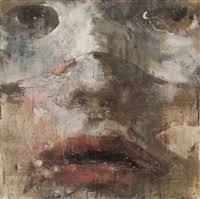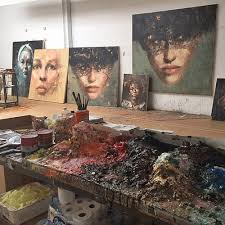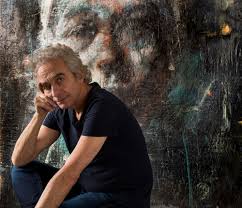WAX POETIC
Posted by Deirdre | Filed under Blog

Encaustic painter Tony Scherman has died and art lovers everywhere will surely mourn his passing. He was a dedicated artist and a principled person. His talent was as his grand as his subject matter— Greek mythology, the French Revolution, Napoleon Bonaparte. His interest in history and historical personages was well matched with encaustic, an ancient technique involving hot wax and colour pigment, as he td me when we worked together on the following article, resurrected here in his memory.

Hot and bothered: Encaustic is a challenging painting method that requires requires plenty of patience and skill — not to mention a pot of scalding wax. It’s one of several ancient media that some contemporary artists swear by.
DEIRDRE KELLY
15 May 1999
Toronto — He’s got sticky fingers, and the floor beneath his feet is studded with balls of wax that give him the feeling of walking on suction cups. All day long.
“I’ve been working in this medium for 25 years,” declares Toronto painter Tony Scherman. “And there’s not a day that goes by that I don’t curse it. I have been in hospital twice because of it and I’ve burned my hands.”
Encaustic is the stuff that’s got him hot and bothered.
An ancient painting technique involving pigments mixed with hot wax, encaustic fell out of favour centuries ago. And no wonder. The process takes time, skill, patience — and courage. Instead of wielding just paint brush or palette knife, encaustic painters also have to balance a pot of scalding wax. Accidents, as Scherman testifies, do happen. Since the fall of Rome at least, more mild-mannered media have tended to get the nod.
But encaustic has had a bit of a revival this century, especially with the 1950s flag and target paintings of American artist Jasper Johns. Since then, a number of contemporary artists have gone back to the ancient medium for inspiration. Next week, an exhibition called Waxing Poetic: Encaustic Art in America,opens at New Jersey’s Montclair Art Museum. And on June 5, Scherman brings his latest show of encaustics, called About 1789, to Toronto’s Sable-Castelli Gallery, after stops in Atlanta, Seattle, Dallas, Paris and Berlin.
Says Scherman: “Contemporary art has forced us into a difficult situation. If we’re to be part of a canon, then we can’t be part of the Starship Enterprise going where no one has ever gone before. That’s the mandate of the avant-garde.” What do you do when everything’s already been done? If you’re like Scherman, you go back to ancient practices and reinvest them with a contemporary sensibility. You use an old technique — encaustic, but also such outmoded media as fresco and egg tempera — to give your work added emotional, intellectual and cultural power.

Michele White, who teaches historical techniques at the Ontario College of Art and Design, believes that the old, if properly used, can create something new. “Each medium has its own character and should be used to enhance the concerns of your content,” White says. “I use whatever media best suit my ideas, and that’s what I teach my students.”
Though hardly a member of the Canadian vanguard, the ever-popular realist painter Ken Danby also found his goals best met through ancient means. He works almost exclusively in the ancient medium of egg tempera, made by adding pigment to egg and diluting it with water. Speaking from his studio in Guelph, Ont., Danby says that his meticulous approach to painting first led him to the technique. “I don’t paint with great fluidity. I prefer to draw and model with paint. When I want to paint large paintings, I use oil because tempera doesn’t accomodate large-scale painting, as it dries so quickly. So I choose the medium according to what I want to achieve in the work. But my main medium has always been tempera, because it is amazingly versatile and potent and no other medium holds colour as well.”
The appeal of the ancient media isn’t only in what they can do, but also in how long they last.
The staying power of encaustic is affirmed by the mummy portraits of Faiyum, dating from between the first century BC and the third century AD. After all these years, their likenesses are as vivid as ever. Plutarch, the Greek historian who lived and worked in ancient Rome, cited encaustic as the epitome of durability: “A beautiful woman leaves in the heart of an indifferent man an image as fleeting as a reflection on water. But in the heart of one who loves, the image is fixed with fire like an encaustic painting which time can never obliterate.”

Encaustic isn’t the only ancient medium that lasts. Danby argues for his own egg tempera as the ultimate survivor. “It really is the most permanent medium that we know of. Paintings that have were done in tempera 2,000 years ago are as fresh as the day they were done.”
The prospect of survival is exciting for contemporary artists who have grown used to the idea that avant-garde work may prove ephemeral. Some of the great experiments of 20th-century painting are already fading into oblivion. Many of the 1950s paintings of Canadian radicals Paul-Emile Borduas and Jean-Paul Riopelle, for instance, are beginning to disintegrate. The heavy bulk of their layered-on colour is literally sliding off the canvas, and surfaces are cracking where paint wasn’t left to dry between layers. Says Rodrigue Bedard, chief restorer at Montreal’s Museum of Fine Arts: “We have collections from the 14th century that are in better condition that work painted just 50 years ago. With conceptual painting, the artist uses any kind of material. Some have made sculptures out of Crisco. What can you do with that?”
So when contemporary artists want their work to live into the next century, they look to the past.
“What I like about encaustic,” says Scherman, “is that I know that my paintings are going to live longer than I will. That gives me a sense of satisfaction.”
